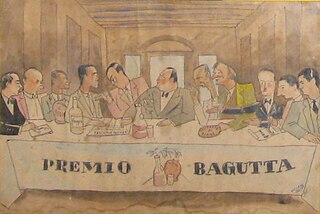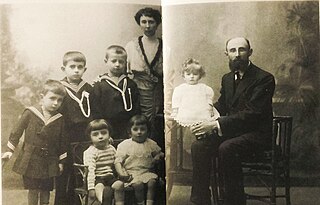
Antonio Fogazzaro was an Italian novelist and proponent of Liberal Catholicism. He was nominated for the Nobel Prize in Literature seven times.

Eugenio Montale was an Italian poet, prose writer, editor and translator, and recipient of the 1975 Nobel Prize in Literature.
Giovanni Comisso was an important Italian writer of the twentieth century, appreciated by Eugenio Montale, Umberto Saba, Gianfranco Contini and many others.

The Bagutta Prize is an Italian literary prize that is awarded annually to Italian writers. The prize originated among patrons of Milan's Bagutta Ristorante. The writer Riccardo Bacchelli discovered the restaurant and soon he regularly gathered numerous friends who would dine there together and discuss books. They began charging fines to the person who arrived last to an appointed meal, or who failed to appear.

Ubaldo Gandolfi (1728–1781) was an Italian painter of the late-Baroque period, mainly active in and near Bologna.

Gianfranco Miglio was an Italian jurist, political scientist, and politician, founder of the Federalist Party. For thirty years, he presided over the political science faculty of Milan's Università Cattolica. Later on in his life, he was elected as an independent member of the Parliament to the Italian Senate for Lega Nord. The supporters of Umberto Bossi's party called him Prufesùr, a Lombard nickname to remember his role.

Helen Frances Barolini was an American writer, editor, and translator. As a second-generation Italian American, Barolini often wrote on issues of Italian-American identity. Among her notable works are Umbertina (1979), a novel which tells the story of four generations of women in one Italian-American family; and an anthology, The Dream Book: An Anthology of Writings by Italian American Women (1985), which called attention to an emerging, and previously unnoticed, class of writers.
Pietro Chiari was an Italian catholic priest, playwright, novelist and librettist.
Fronte Nuovo delle Arti was an Italian artistic movement active in Venice, Rome and Milan in the years following WWII. It is considered to be part of the post-cubism movement.

The church of San Marcuola is a religious building facing the Grand Canal and located in the sestiere of Cannaregio in Venice, Italy. It is dedicated to the saints Hermagoras and Fortunatus. Palazzo Memmo Martinengo Mandelli is a neighboring building.

Teodolinda Barolini is the Lorenzo Da Ponte Professor of Italian at Columbia University, and has twice served as Chair of the Department of Italian.
Erminia Dell'Oro is an Italian writer and novelist born in the Italian Eritrea.

The Morassutti family is an Italian family, originally from Friuli Venezia Giula, that has been active in the wholesaler and retail hardware trade since the early nineteenth century. They are mostly known for having started one of the few distribution chain of hardware and household articles during the thirties of the twentieth century.

Rosella Postorino is an Italian author. In 2013 she won the International Prize Città di Penne and in 2018 she won the Rapallo Carige Prize and the Premio Campiello.

The Jewel of Vicenza was a silver model of the city of Vicenza made as an ex-voto in the 16th century and attributed to the architect Andrea Palladio. The Jewel was stolen by the Napoleonic army during the Italian Campaign in the French Revolutionary Wars and subsequently destroyed. A copy was created between 2012 and 2013.

Angela Veronese was an Italian poet.

Alessandro Gerbi, known as Sandro is an Italian journalist, author of several biographies and books on Italian contemporary history.

Bagni di Craveggia is a frazione of the municipality of Craveggia, in Piedmont, northern Italy. It is located in Valle Onsernone at 986 m (3,235 ft), on the border with the Swiss municipality of Onsernone via the village of Comologno and is crossed by the Isorno river. It owes its name to a source of thermal water at 28 °C (82 °F).
Remondini was a firm of print publishers, based in Bassano del Grappa from the mid-17th century to 1860, which was run by consecutive generations of the Remondini family:














